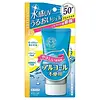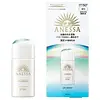What's inside
What's inside
 Key Ingredients
Key Ingredients

 Benefits
Benefits

 Concerns
Concerns

 Ingredients Side-by-side
Ingredients Side-by-side

Water
Skin ConditioningMethoxycinnamic Acid
StabilisingDiethylamino Hydroxybenzoyl Hexyl Benzoate
UV FilterPentylene Glycol
Skin ConditioningSodium Acetylated Hyaluronate
HumectantSodium Hyaluronate
HumectantHydrolyzed Hyaluronic Acid
HumectantAorta Extract
Skin ConditioningAloe Barbadensis Leaf Extract
EmollientRoyal Jelly Extract
Skin ConditioningIsononyl Isononanoate
EmollientBis-Ethylhexyloxyphenol Methoxyphenyl Triazine
Skin ConditioningAcrylamide/Sodium Acryloyldimethyltaurate/Acrylic Acid Copolymer
Titanium Dioxide
Cosmetic ColorantIsohexadecane
EmollientSuccinic Acid
BufferingButylene Glycol
HumectantEthylhexylglycerin
Skin ConditioningPolysorbate 80
EmulsifyingLysine Lauroyl Glutamate
CleansingAluminum Hydroxide
EmollientStearic Acid
CleansingXanthan Gum
EmulsifyingSorbitan Oleate
EmulsifyingPhenoxyethanol
PreservativeParfum
MaskingAmmonium Acryloyldimethyltaurate/Vp Copolymer
BHT
AntioxidantT-Butyl Alcohol
PerfumingWater, Methoxycinnamic Acid, Diethylamino Hydroxybenzoyl Hexyl Benzoate, Pentylene Glycol, Sodium Acetylated Hyaluronate, Sodium Hyaluronate, Hydrolyzed Hyaluronic Acid, Aorta Extract, Aloe Barbadensis Leaf Extract, Royal Jelly Extract, Isononyl Isononanoate, Bis-Ethylhexyloxyphenol Methoxyphenyl Triazine, Acrylamide/Sodium Acryloyldimethyltaurate/Acrylic Acid Copolymer, Titanium Dioxide, Isohexadecane, Succinic Acid, Butylene Glycol, Ethylhexylglycerin, Polysorbate 80, Lysine Lauroyl Glutamate, Aluminum Hydroxide, Stearic Acid, Xanthan Gum, Sorbitan Oleate, Phenoxyethanol, Parfum, Ammonium Acryloyldimethyltaurate/Vp Copolymer, BHT, T-Butyl Alcohol
Tranexamic Acid
AstringentWater
Skin ConditioningCyclopentasiloxane
EmollientEthylhexyl Methoxycinnamate
UV AbsorberEthyl Trisiloxane
Skin ConditioningAlcohol Denat.
AntimicrobialMethyl/Phenyl Polysilsesquioxane
Diisopropyl Sebacate
EmollientC12-15 Alkyl Benzoate
AntimicrobialPEG-8 Dimethicone
EmulsifyingButylene Glycol
HumectantGlycerin
HumectantPEG-9 Polydimethylsiloxyethyl Dimethicone
EmulsifyingPolypropylene Glycol
PEG-3 Glyceryl Triisostearate
EmollientSorbitan Sesquiisostearate
EmulsifyingSilica
AbrasiveTalc
AbrasiveHydrated Silica
AbrasiveBis-Ethylhexyloxyphenol Methoxyphenyl Triazine
Skin ConditioningStearic Acid
CleansingAluminum Hydroxide
Emollient4-Hydroxybenzoic Acid
PreservativeDisteardimonium Hectorite
StabilisingIsostearic Acid
CleansingPhytosteryl Macadamiate
Skin ConditioningTrisodium EDTA
Tocopherol
AntioxidantBHT
AntioxidantSodium Metabisulfite
AntioxidantSodium Polyacrylate
AbsorbentLaminaria Digitata Extract
Skin ProtectingGlycine Soja Seed Extract
Skin ConditioningMelaleuca Alternifolia Leaf Extract
PerfumingAcmella Oleracea Extract
Skin ProtectingSodium Acetylated Hyaluronate
HumectantTrimethylsiloxysilicate
EmollientRosa Extract
AstringentRubus Idaeus Extract
Skin ProtectingSoluble Collagen
HumectantParfum
MaskingZinc Oxide
Cosmetic ColorantTitanium Dioxide
Cosmetic ColorantCI 77491
Cosmetic ColorantTranexamic Acid, Water, Cyclopentasiloxane, Ethylhexyl Methoxycinnamate, Ethyl Trisiloxane, Alcohol Denat., Methyl/Phenyl Polysilsesquioxane, Diisopropyl Sebacate, C12-15 Alkyl Benzoate, PEG-8 Dimethicone, Butylene Glycol, Glycerin, PEG-9 Polydimethylsiloxyethyl Dimethicone, Polypropylene Glycol, PEG-3 Glyceryl Triisostearate, Sorbitan Sesquiisostearate, Silica, Talc, Hydrated Silica, Bis-Ethylhexyloxyphenol Methoxyphenyl Triazine, Stearic Acid, Aluminum Hydroxide, 4-Hydroxybenzoic Acid, Disteardimonium Hectorite, Isostearic Acid, Phytosteryl Macadamiate, Trisodium EDTA, Tocopherol, BHT, Sodium Metabisulfite, Sodium Polyacrylate, Laminaria Digitata Extract, Glycine Soja Seed Extract, Melaleuca Alternifolia Leaf Extract, Acmella Oleracea Extract, Sodium Acetylated Hyaluronate, Trimethylsiloxysilicate, Rosa Extract, Rubus Idaeus Extract, Soluble Collagen, Parfum, Zinc Oxide, Titanium Dioxide, CI 77491
 Reviews
Reviews

Ingredients Explained
These ingredients are found in both products.
Ingredients higher up in an ingredient list are typically present in a larger amount.
Aluminum Hydroxide is a form of aluminum. It can be naturally found in nature as the mineral gibbsite. In cosmetics, Aluminum Hydroxide is used as a colorant, pH adjuster, and absorbent.
As a colorant, Aluminum Hydroxide may add opacity, or reduce the transparency. Aluminum hydroxide is contains both basic and acidic properties.
According to manufacturers, this ingredient is an emollient and humectant. This means it helps hydrate the skin.
In medicine, this ingredient is used to help relieve heartburn and help heal ulcers.
There is currently no credible scientific evidence linking aluminum hydroxide in cosmetics to increased cancer risk.
Major health organizations allow the use of aluminum hydroxide in personal care products and have not flagged it as a carcinogenic risk at typical usage levels.
Learn more about Aluminum HydroxideBHT is a synthetic antioxidant and preservative.
As an antioxidant, it helps your body fight off free-radicals. Free-radicals are molecules that may damage your skin cells.
As a preservative, it is used to stabilize products and prevent them from degrading. Specifically, BHT prevents degradation from oxidation.
The concerns related to BHT come from oral studies; this ingredient is currently allowed for use by both the FDA and EU.
However, it was recently restricted for use in the UK as of April 2024.
Learn more about BHTYou might know this ingredient as Tinosorb S or Bemotrizinol. It is a UV filter that covers both UVA and UVB rays.
This ingredient has two peak UV absorption peaks ( 310 and 340 nm) and is able to absorb both UV-A and UV-B rays. This ingredient works by preventing UV rays from reaching and damaging your skin.
On top of that - it is highly photostable and helps prevent the photodegration of other sunscreen ingredients such as avobenzone.
Tinosorb S is allowed in the EU, Australia, and Asia. It is close to being approved by the FDA and we'll hopefully get this ingredient in the U.S. by late 2025.
Fun fact: Tinosorb S is the most effective UV absorber at maximum concentration (measured by SPF) permitted in the EU.
This ingredient is oil-soluble, so your oil-cleansers will take this right off at night.
Learn more about Bis-Ethylhexyloxyphenol Methoxyphenyl TriazineButylene Glycol (or BG) is used within cosmetic products for a few different reasons:
Overall, Butylene Glycol is a safe and well-rounded ingredient that works well with other ingredients.
Though this ingredient works well with most skin types, some people with sensitive skin may experience a reaction such as allergic rashes, closed comedones, or itchiness.
Learn more about Butylene GlycolParfum is a catch-all term for an ingredient or more that is used to give a scent to products.
Also called "fragrance", this ingredient can be a blend of hundreds of chemicals or plant oils. This means every product with "fragrance" or "parfum" in the ingredients list is a different mixture.
For instance, Habanolide is a proprietary trade name for a specific aroma chemical. When used as a fragrance ingredient in cosmetics, most aroma chemicals fall under the broad labeling category of “FRAGRANCE” or “PARFUM” according to EU and US regulations.
The term 'parfum' or 'fragrance' is not regulated in many countries. In many cases, it is up to the brand to define this term.
For instance, many brands choose to label themselves as "fragrance-free" because they are not using synthetic fragrances. However, their products may still contain ingredients such as essential oils that are considered a fragrance by INCI standards.
One example is Calendula flower extract. Calendula is an essential oil that still imparts a scent or 'fragrance'.
Depending on the blend, the ingredients in the mixture can cause allergies and sensitivities on the skin. Some ingredients that are known EU allergens include linalool and citronellol.
Parfum can also be used to mask or cover an unpleasant scent.
The bottom line is: not all fragrances/parfum/ingredients are created equally. If you are worried about fragrances, we recommend taking a closer look at an ingredient. And of course, we always recommend speaking with a professional.
Learn more about ParfumSodium Acetylated Hyaluronate is a type of Hyaluronic Acid.
Hyaluronic Acids help moisturize, soothe, and protect the skin.
Read about common types of Hyaluronic Acid here:
Sodium Hyaluronate
Hydrolyzed Hyaluronic Acid
Hyaluronic Acid
Stearic Acid is a fatty acid. It is an emollient, emulsifier, and texture enhancer.
As an emollient, stearic acid helps soften skin. It aids the skin's protective barrier by preventing water loss. It also provides a gentle cleansing effect without stripping away natural oils.
Stearic acid may also be used to enhance the texture of products. It can add volume and stabilize ingredients such as water and oil. This can help water and oil ingredients from separating.
Sources of stearic acid include animal or vegetable fats/oils such as coconut or shea. It can be naturally found in butter, cocoa butter, shea butter, vegetable fats, and animal tallow.
This ingredient may not be Malassezia folliculitis, or fungal-acne safe.
Learn more about Stearic AcidTitanium dioxide is a mineral UV filter widely used in sunscreens and cosmetics.
It is one of only two UV filters officially classified as “mineral” by regulatory agencies, the other being zinc oxide.
Titanium dioxide provides broad-spectrum protection mostly in the UVB and UVAII range, with some protection in the UVAI range.
While its UVA protection isn’t as strong as zinc oxide’s, the difference is minor.
A common myth is that mineral UV filters reflect UV light. However, modern research shows titanium dioxide absorbs UV radiation like chemical filters (~95% absorption & 5% reflection).
Thanks to its non-irritating nature, titanium dioxide is suitable for sensitive, acne-prone, or redness-prone skin. It is unlikely to cause "eye sting" like other sunscreen ingredients.
A major drawback of this ingredient is its white cast and thick texture. This is why mineral sunscreens often leave a white cast and are less cosmetically elegant than chemical/hybrid sunscreens.
To improve white cast and spreadability, micronized or nano-sized titanium dioxide is often used.
There are ongoing concerns surrounding nano-titanium oxide's impact on marine ecosystems.
There is no conclusive evidence that any form of titanium oxide (or any other sunscreen ingredients) will cause harm to marine ecosystems or coral reefs. The science is still developing but many consumers are keeping a close eye on this issue.
Please note, many destinations have reef-safety sunscreen rules. For instance, the U.S. Virgin Islands advises all visitors to use non-nano mineral sunscreens.
Nano mineral sunscreens once raised safety concerns about absorption into skin.
Extensive research has shown that they do not penetrate healthy or damaged skin; they remain safely on the surface and the top layer of dead skin (stratum corneum).
You'll likely find titanium dioxide bundled with alumina, silica, or dimethicone. These ingredients help make titanium dioxide highly photostable; this prevents it from interacting with other formula components under UV light.
Learn more about Titanium DioxideWater. It's the most common cosmetic ingredient of all. You'll usually see it at the top of ingredient lists, meaning that it makes up the largest part of the product.
So why is it so popular? Water most often acts as a solvent - this means that it helps dissolve other ingredients into the formulation.
You'll also recognize water as that liquid we all need to stay alive. If you see this, drink a glass of water. Stay hydrated!
Learn more about Water